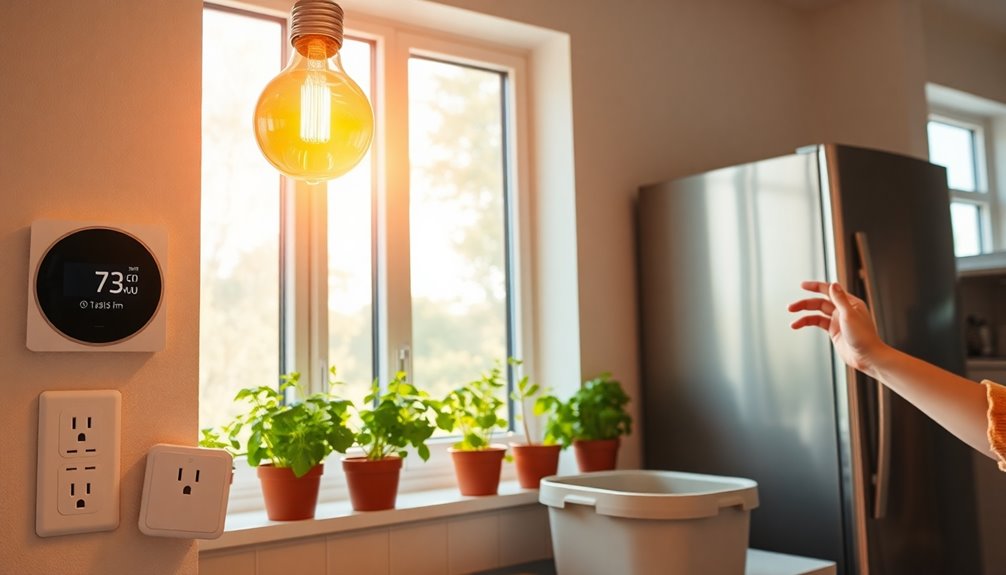To save energy and lower your bills, start by upgrading to energy-efficient appliances and using smart thermostats to optimize heating and cooling. Seal gaps in your home to prevent drafts and switch to LED lighting for better efficiency. Unplug unused electronics and use power strips for easier control. Take advantage of natural light during the day and reduce water heating expenses. Practicing these energy-conscious habits can significantly lower your costs, and there's more to explore!
Key Takeaways
- Upgrade to ENERGY STAR-rated appliances to reduce energy consumption and lower utility bills.
- Optimize heating and cooling by using smart thermostats and maintaining HVAC systems regularly.
- Seal drafts and insulate your home to enhance energy efficiency and prevent heat loss.
- Switch to LED lighting for significant energy savings and longer-lasting illumination.
- Implement general energy-saving practices, like unplugging devices, using cold water for laundry, and scheduling appliance use during off-peak hours.
Upgrade to Energy-Efficient Appliances
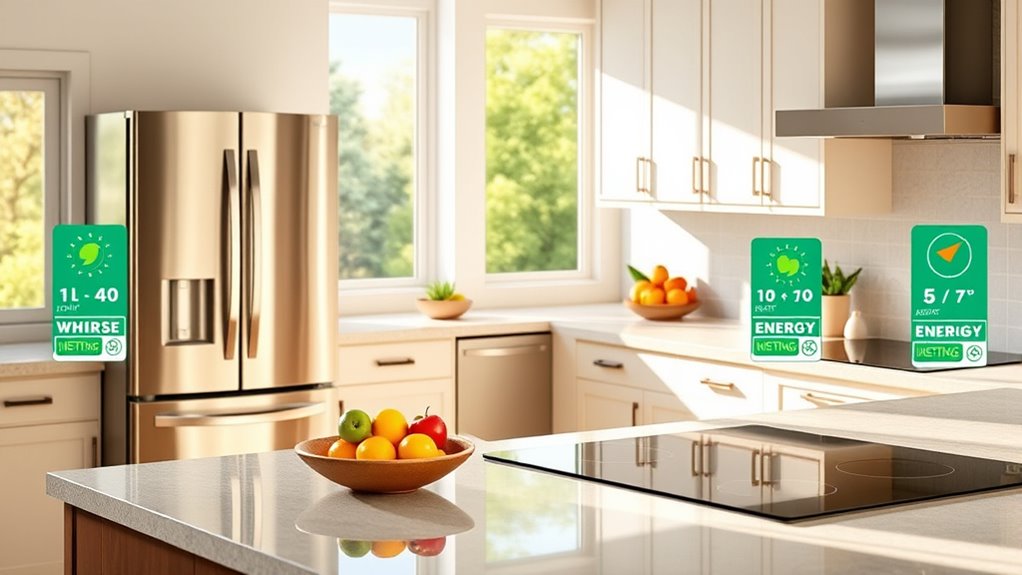
When you upgrade to energy-efficient appliances, you not only reduce your energy bills but also contribute to a healthier planet.
These appliances use advanced technology to consume less electricity and water, making them smarter choices for your home. By replacing old, inefficient models, you can save significant amounts on your monthly utility costs.
Look for products with the ENERGY STAR label, as they meet strict efficiency guidelines. You'll find that many energy-efficient appliances operate quietly and perform just as well, if not better, than their traditional counterparts.
Plus, some utility companies even offer rebates for purchasing these appliances. Investing in energy-efficient options is a win-win, benefiting both your wallet and the environment.
Make the switch today!
Utilize Smart Thermostats
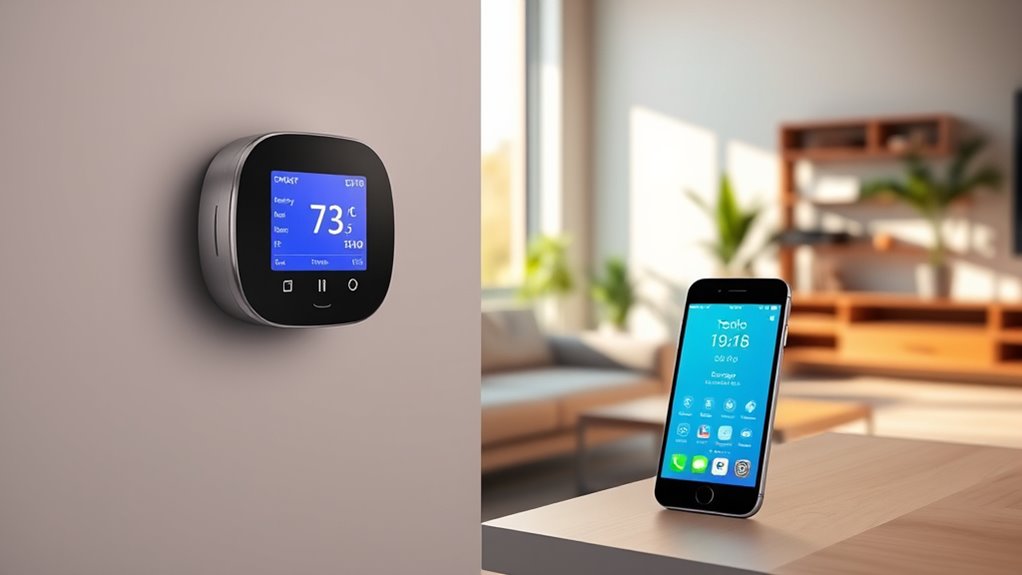
Utilizing smart thermostats can significantly enhance your home's energy efficiency while providing you with greater control over your heating and cooling systems.
These devices learn your schedule and adjust temperatures accordingly, ensuring you're not wasting energy when you're away. You can control them remotely via your smartphone, allowing you to make adjustments on the go.
Setting up energy-saving modes during peak hours can drastically lower your bills. Many smart thermostats even provide usage reports, helping you identify patterns and areas for improvement.
Plus, some can integrate with other smart home devices, creating a seamless energy management system. By investing in a smart thermostat, you'll enjoy comfort and savings, making it a wise choice for any homeowner.
Seal and Insulate Your Home
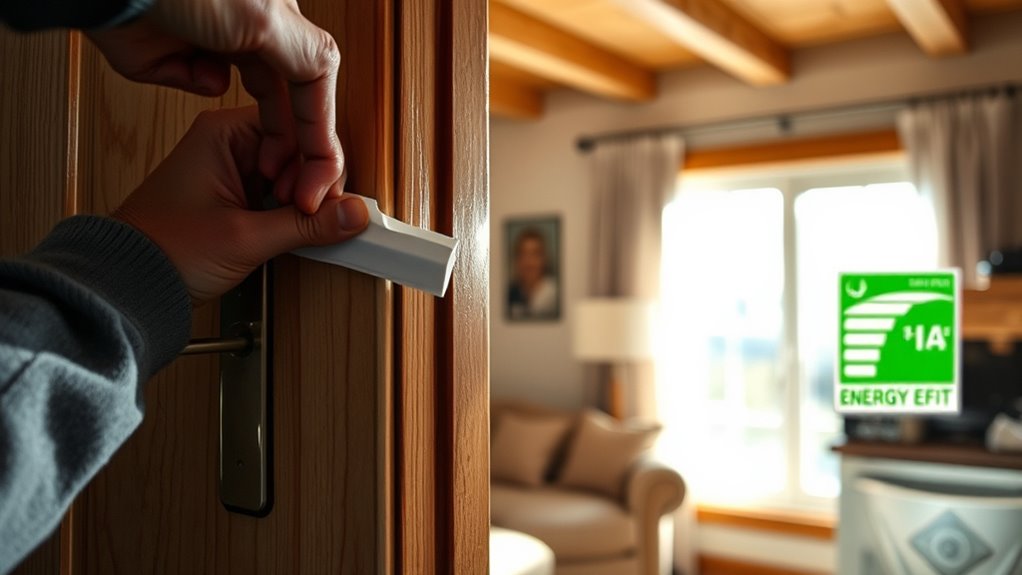
Smart thermostats can help manage your energy use, but they won't be as effective if your home isn't properly sealed and insulated.
Start by checking for drafts around windows and doors. Use weatherstripping and caulk to fill gaps that let air escape.
Check for drafts around windows and doors, then seal gaps with weatherstripping and caulk to prevent air leaks.
Insulating your attic, walls, and floors adds another layer of protection against temperature fluctuations. Don't forget to insulate your pipes, too; it helps prevent heat loss and can save you money on heating bills.
Also, consider adding insulation to your basement or crawl space if you have one.
These simple steps can drastically reduce your energy consumption, making your home more comfortable year-round while lowering your utility bills.
A well-sealed and insulated home is the foundation of energy efficiency.
Switch to LED Lighting
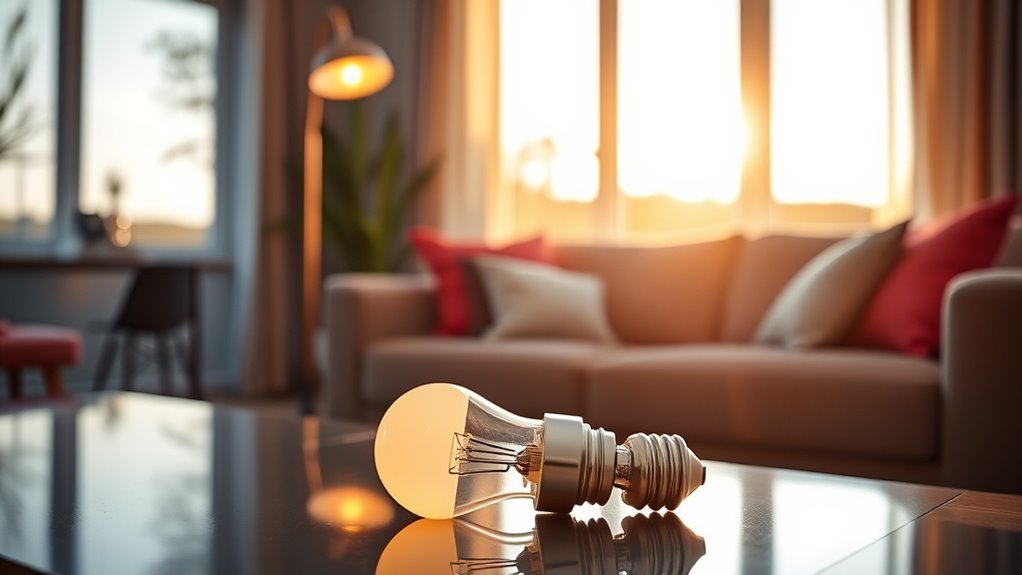
Switching to LED lighting can significantly reduce your energy consumption and lower your electricity bills. LEDs use up to 80% less energy than traditional incandescent bulbs, making them an excellent choice for any home.
Not only do they save you money, but they also last much longer—up to 25,000 hours compared to about 1,000 hours for incandescent bulbs. By replacing your old bulbs with LEDs, you'll notice the difference in your energy bill almost immediately.
Plus, they come in various colors and styles, allowing you to create the perfect ambiance in any room. Making the switch is simple and can lead to substantial savings over time, so why not start today?
Your wallet—and the environment—will thank you!
Unplug Unused Electronics
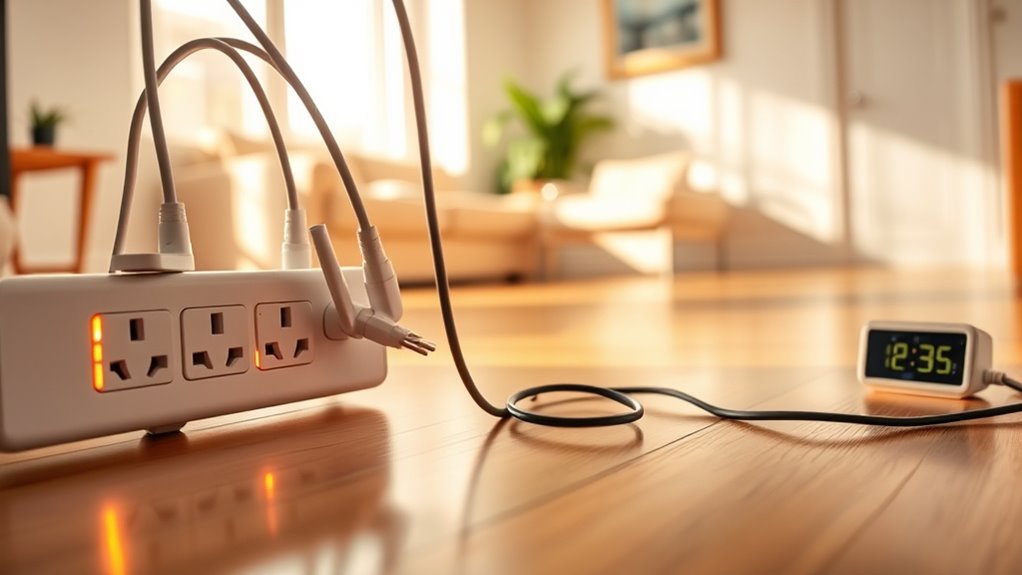
After enhancing your home with energy-efficient LED lighting, consider another simple way to save energy: unplugging unused electronics.
Many devices, like chargers, TVs, and computers, consume power even when they're turned off—this is known as phantom load. By unplugging these devices when you're not using them, you can significantly reduce your energy consumption and lower your bills.
Think about using power strips to make it easier; you can turn off multiple devices at once. Set a reminder to unplug electronics before you leave home or go to bed.
It's a small change that can lead to noticeable savings over time. So, take a few minutes to unplug those idle gadgets and enjoy the benefits of a more energy-efficient home.
Optimize Your Heating and Cooling Systems

To ensure your home stays comfortable while minimizing energy use, it's essential to optimize your heating and cooling systems.
Start by scheduling regular maintenance for your HVAC unit; a clean filter and well-lubricated parts can improve efficiency.
Next, consider upgrading to a programmable thermostat that adjusts temperatures based on your routine. This way, your system won't work harder than necessary when you're away.
Upgrading to a programmable thermostat can optimize energy use by adjusting temperatures according to your schedule.
Additionally, seal any gaps around windows and doors to prevent drafts, and use ceiling fans to circulate air, which can help you feel cooler in summer and warmer in winter.
Finally, insulate your home effectively to maintain the desired temperature, reducing the need for excessive heating or cooling.
Use Power Strips for Electronics
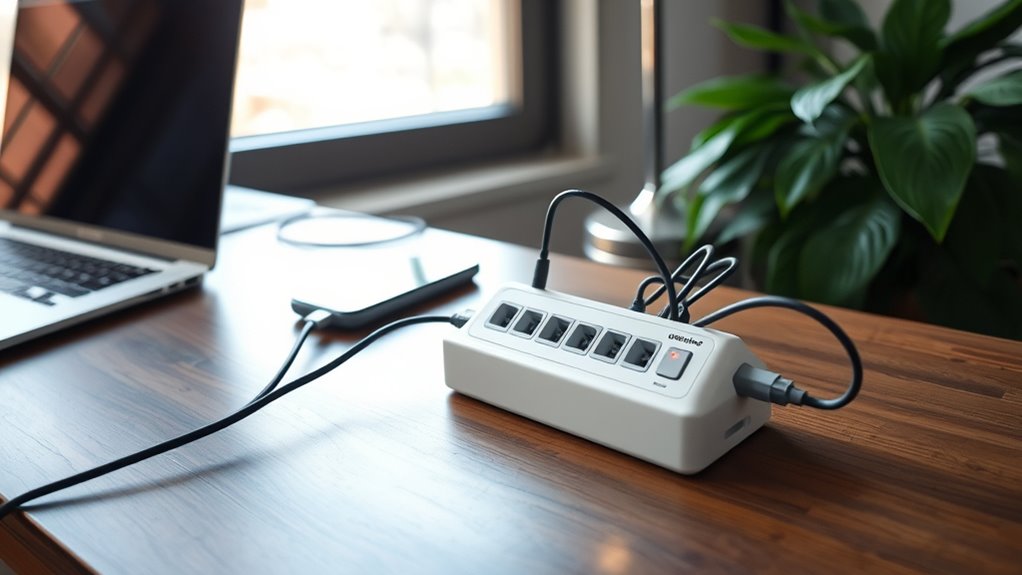
Have you ever noticed how many electronics you leave plugged in, even when they're not in use? These devices can still draw power, leading to unnecessary energy waste.
One effective way to combat this is by using power strips. With a power strip, you can plug multiple devices into one outlet and easily switch them off when you're done. This simple action cuts off power to your electronics, preventing phantom energy use.
Look for power strips with a switch or even smart strips that automatically turn off power when devices aren't in use. By making this small change, you'll not only save energy but also lower your monthly bills, making your home more energy-efficient.
Don't let your electronics drain your wallet!
Take Advantage of Natural Light
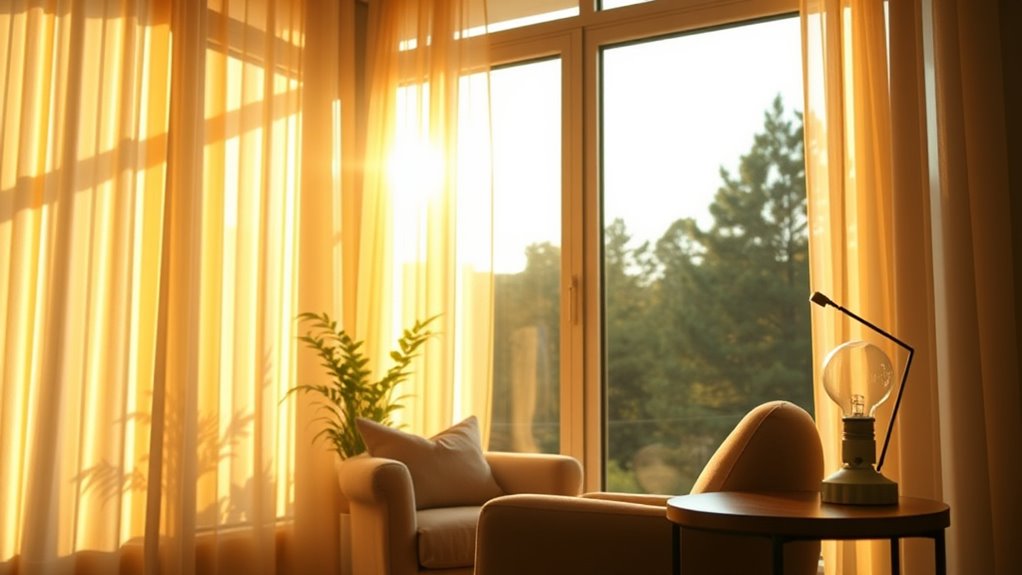
While you mightn't realize it, taking advantage of natural light can significantly reduce your energy consumption. By opening your curtains or blinds during the day, you let sunlight brighten your home, which means you won't need to rely on artificial lighting as much.
Position your furniture near windows to maximize the sun's rays and create a warm, inviting atmosphere. You can also consider using lighter colors for your walls and décor, which reflect light and enhance brightness.
If you're looking for a more permanent solution, think about installing skylights or larger windows. Not only will this lower your electricity bills, but it'll also improve your mood and overall well-being.
Reduce Water Heating Expenses
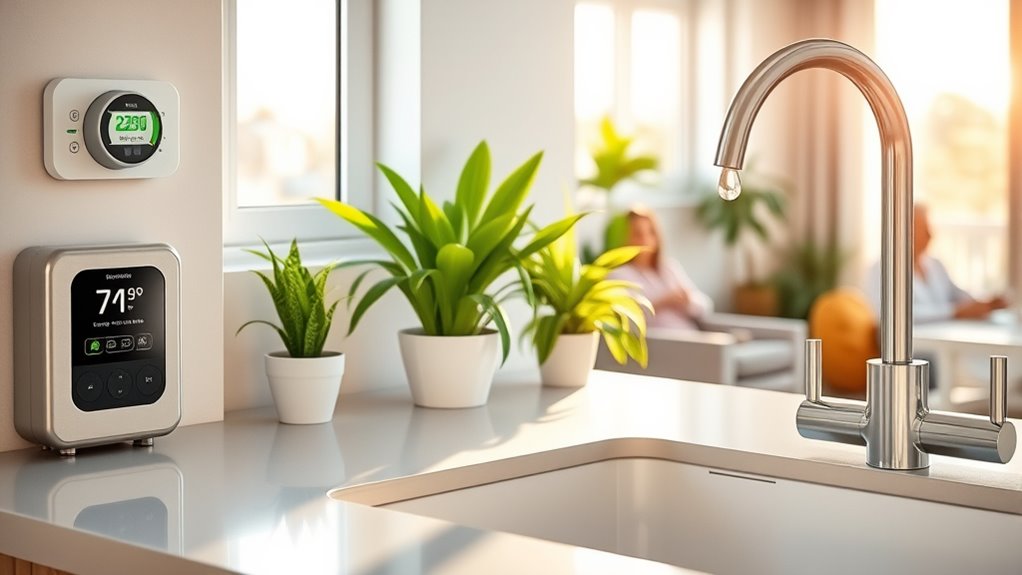
After maximizing natural light in your home, it's time to tackle another significant area of energy consumption: water heating.
First, consider lowering your water heater's temperature to 120°F. This simple adjustment can save you money without sacrificing comfort.
Next, insulate your water heater and the first few feet of hot water pipes to minimize heat loss. You might also want to invest in a timer for your water heater, ensuring it operates only when needed.
Additionally, consider switching to an energy-efficient model if your current unit is old.
If you can, use cold water for laundry and limit long showers.
Practice Energy-Conscious Habits

Practicing energy-conscious habits can significantly impact your utility bills and the environment.
Start by turning off lights in rooms you're not using and unplugging devices when they're not in use. Consider using energy-efficient LED bulbs, which last longer and use less power.
When you cook, try to use lids on pots to retain heat, and batch cook meals to save energy. Adjust your thermostat a few degrees; even a small change can lead to substantial savings.
Remember to wash clothes in cold water and only run full loads in your dishwasher and laundry machine.
Frequently Asked Questions
How Much Can I Save by Using Energy-Efficient Appliances?
Using energy-efficient appliances can lead to significant savings on your utility bills.
You can save anywhere from 10% to 50% compared to standard models, depending on the appliance type. For instance, energy-efficient refrigerators or washing machines often use less electricity and water.
Over time, these savings add up, making the initial investment worthwhile. Plus, you'll contribute to a more sustainable environment, which is a win-win for both your wallet and the planet.
Are Smart Thermostats Worth the Investment?
Imagine your home as a cozy cabin in the woods, perfectly warm without wasting a single log.
Smart thermostats can help you achieve that comfort by learning your habits and adjusting temperatures automatically. You'll save energy and money, making the investment worthwhile.
With remote access, you can control your home's climate from anywhere, ensuring you return to a welcoming environment.
What Insulation Materials Are Most Effective?
When you're choosing insulation materials, consider options like spray foam, fiberglass batts, and cellulose.
Spray foam offers excellent air sealing and high R-values, making it great for energy efficiency.
Fiberglass batts are cost-effective and easy to install, while cellulose, made from recycled materials, provides good thermal performance.
Each material has its pros and cons, so think about your specific needs and budget to find the best fit for your home.
How Often Should I Replace LED Bulbs?
Think of your LED bulbs as the unsung heroes of your home lighting.
You should replace them every 10 to 20 years, depending on usage. If you notice flickering or dimming, it's time for a change.
Regularly checking your bulbs can help you maintain a bright and inviting atmosphere.
Just remember, even heroes need a refresh every now and then to keep shining their best!
Does Unplugging Electronics Really Make a Difference?
Yes, unplugging electronics can make a difference.
Many devices continue to draw power even when they're turned off, a phenomenon known as "phantom load." By unplugging them, you eliminate this unnecessary energy consumption.
It might seem small, but over time, those savings can add up on your bills. Plus, you'll reduce the environmental impact.
Conclusion
By making these energy-saving changes, you not only cut your bills but also contribute to a healthier planet. Did you know that if every American swapped just one incandescent bulb for an LED, we could save enough energy to power 3 million homes for a year? It's a small step that packs a big punch. So, start implementing these strategies today, and watch your savings grow while making a positive impact on the environment!
